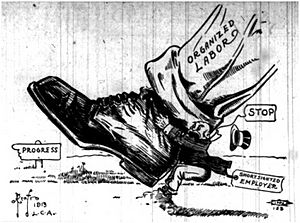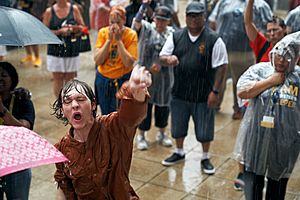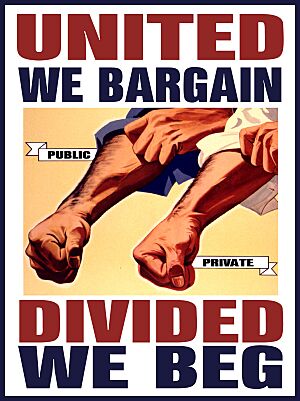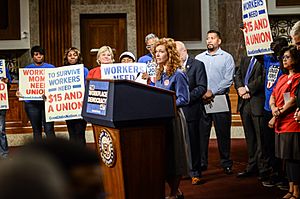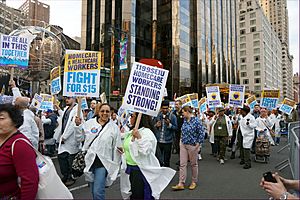Labor unions in the United States facts for kids
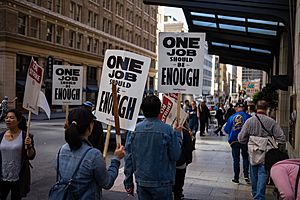
Hotel union workers strike with the slogan "One job should be enough"
|
|
| National organization(s) | AFL–CIO, SOC, IWW |
|---|---|
| Regulatory authority | United States Department of Labor National Labor Relations Board |
| Primary legislation | National Labor Relations Act Taft–Hartley Act |
| Total union membership | 14.3 million |
| Percentage of workforce unionized | 10.8% |
| International Labour Organization | |
| United States is a member of the ILO | |
| Convention ratification | |
| Freedom of Association | Not ratified |
| Right to Organise | Not ratified |
Labor unions are groups of workers who join together in the United States. They work to improve their pay, benefits, and working conditions. These groups are officially recognized under US law since 1935.
Unions help their members by negotiating with employers. This process is called collective bargaining. They also help solve problems between workers and their bosses. Many larger unions also talk to government leaders about laws that affect workers.
Most unions in the U.S. belong to one of two big groups. These are the AFL–CIO and the Change to Win Federation. Both groups work to support workers in the U.S. and Canada. They also play a role in politics.
In 2020, about 10.8% of workers in the U.S. were union members. This is less than the 20.1% in 1983. There were 14.3 million union members in 2020. This is down from 17.7 million in 1983.
Union membership is much higher for public sector workers (like teachers or government employees). About 34.8% of them are in unions. For private sector workers, only 6.3% are union members.
Today, many strong unions are found among public sector workers. This includes city workers, government employees, teachers, and police. Union members often earn 10-30% more than non-union workers. This is true even when comparing similar jobs and skills.
Unions are still important in politics, even with fewer members. They work with other groups on issues like immigrant rights and environmental protection. They also support better healthcare and fair wages. Research shows that unions help reduce the gap between rich and poor.
Contents
History of Labor Unions
Unions started forming in the mid-1800s. This was during the Industrial Revolution. Many people worked long hours for low pay in unsafe factories. Unions aimed to make things better for these workers.

After the Civil War, national unions began to grow. The Knights of Labor was a big union in the 1880s. But it faced problems and eventually broke apart.
The American Federation of Labor (AFL) was founded in 1886. Samuel Gompers led it for many years. It was a group of local unions that worked together. The AFL became very important in national politics. It often supported the Democratic Party.
Unions grew a lot during the 1930s. This was thanks to President Franklin D. Roosevelt's New Deal policies. The Wagner Act was a key law passed in 1935. It legally protected workers' right to form unions.
After World War II
In 1947, a new law called the Taft–Hartley Act was passed. This law made it harder for unions to strike. It also limited how unions could support political candidates. Unions tried to get rid of this law, but they failed.
In 1955, the two largest labor groups, the AFL and the CIO, joined together. This created the AFL–CIO. This merger ended a split that had lasted over 20 years.
Union membership in the U.S. was highest in 1954. Almost 35% of workers were in unions then. The total number of union members peaked in 1979. Since then, membership has gone down, especially in the private sector.

However, public sector unions grew quickly after 1960. They helped their members get good pay and pensions. By 2010, about 8.4 million government workers were in unions. This included federal, state, and local employees.
In the 1970s and 1980s, many American factories faced challenges. Imports from other countries increased. Many companies moved their factories to places where unions were weaker. Some even moved factories to other countries. This led to fewer strikes and less union power.
A big moment happened in 1981. President Ronald Reagan fired many striking air traffic controllers. This was a major setback for unions.
Labor Unions Today
Today, most labor unions in the U.S. are part of the American Federation of Labor–Congress of Industrial Organizations (AFL–CIO) or the Change to Win Federation. These groups work to support laws that help workers. They are also active in politics.
Unions in the private sector follow the National Labor Relations Act (NLRA). The National Labor Relations Board (NLRB) makes sure this law is followed. Public sector unions follow both federal and state laws. They have grown because their pay and conditions are set by talking with elected officials.
To join a union, workers can either be recognized by their employer. Or, most workers in a workplace can vote to have a union. The government then officially approves the union.
If workers are in a union, they often earn more money. They also tend to have more job security. Their workplaces are often safer and have better conditions. In 2014, union workers earned about $973 per week. Non-union workers earned about $763.
Since 2015, many new media and newspaper companies have formed unions. This happened after job losses during the Great Recession.
How Unions Negotiate
Once a union is officially recognized, it can negotiate for its members. The union and the employer write down the rules for jobs in a contract. This contract is legally binding.
If there are disagreements, they try to solve them through a process called a grievance. If they still can't agree, a neutral third party can help. This is called arbitration.
Some states have "right-to-work" laws. These laws stop unions from requiring all workers to join the union. This can make unions weaker in those states.
Union members have "Weingarten Rights." If a boss questions a union member about something that could lead to punishment, the worker can ask for a union representative to be there.
The NLRA also protects workers' right to work together for their own good. This is called "concerted activity." It means workers can talk to each other about their jobs. They don't need a union to do this.
Unions are pushing for a new law called the Employee Free Choice Act (EFCA). This law would make it easier for workers to form a union. Workers could sign cards to show they want a union. Currently, workers usually need to vote in a secret ballot election.
Unions say that employers often try to stop unions during the secret ballot process. Some people worry that the EFCA could lead to unions pressuring workers.
Union Membership Numbers
Union membership in the U.S. has been falling since 1954. As union membership went down, the income of the middle class also changed. In 2007, union membership increased for the first time in 25 years. Most of this growth was in the service industry.
Historically, public employee unions grew a lot since the 1960s. This hid the bigger drop in private sector union members. In the 1940s, about 33.9% of private workers were in unions. Only 9.8% of public workers were. Today, these numbers are almost reversed. About 36% of public workers are in unions, but only about 7% of private workers are.
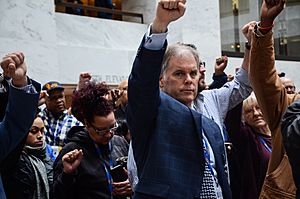
Between 2005 and 2014, workers voted for union representation in 60% of elections.
Labor Education
Some universities offer programs to educate union members. For example, Harvard Law School has a program that teaches about workplace issues and labor laws.
Cornell University is also a major center for labor education. Its School of Industrial and Labor Relations teaches students about labor policy and improving working lives.
Union Areas of Work
Unions use the word jurisdiction to mean which workers they represent. For example, different unions might claim the right to unload cargo at ports. A jurisdictional strike happens when a union stops work to say its members should do a certain job. This often happens in the construction industry.
Unions also use jurisdiction to mean their geographical area. A national union might give local unions the right to represent workers in certain cities or states.
Working with Environmental Groups
To gain more power, unions started working with other groups in the 1980s. These included religious groups, social movements, and environmental groups. This was a new step, as unions and environmental groups had not always worked together well.
Unions usually focus on jobs and workers' rights. Environmental groups focus on protecting nature. Sometimes, environmental rules could affect jobs. But they found common ground on issues like global trade and health.
Unions and environmental groups first worked together internationally in the 1980s. This was when the government tried to weaken environmental rules and also fired striking workers.
Public Opinion on Unions
Most Americans approve of labor unions. Gallup polls have tracked this since 1936. In 2018, 62% of Americans approved of unions. This was the highest level in over a decade.
However, opinions are split on whether unions should have more or less influence. In 2018, 39% wanted unions to have more influence. 29% wanted less, and 26% wanted their influence to stay the same.
Support for unions dropped during the Great Recession around 2009. But it rose again by 2018.
Why Union Membership Has Changed
Union membership has dropped in many industrialized countries. But the drop has been bigger in the United States.
Global Trends
From 1970 to 2003, union membership fell in most advanced economies. For example, in Australia, it fell from 50.2% to 22.9%. In the U.S., it went from 23.5% to 12.4%. Some countries like Finland and Sweden saw increases.
Popularity and Influence
Public approval of unions went up in the 1980s. But it fell below 50% in 2009 during the Great Recession. It's not clear if this was a long-term change or just because of high unemployment.
One reason for less public support might be that fewer people belong to unions. Unions no longer have the same "threat effect." This means they can't as easily push non-union companies to raise wages.
Laws Affecting Unions
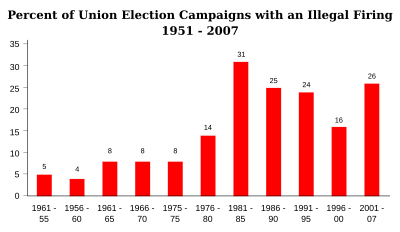
Some experts say the Taft–Hartley Act from 1947 had a big impact. This law made it harder for unions to organize. It also allowed employers to hold meetings to discourage workers from joining unions.
The law also made it harder for unions to fight back against employers. Before this law, unions could use tactics like mass picketing. But Taft-Hartley made these actions illegal. This led to more "union-busting" by employers.
Global Economy and Unions
The global economy also plays a role. Companies can move production to countries with lower wages. This can reduce unions' power to negotiate.
However, some argue that strong unions can still help a country's industry. Countries like Sweden and Germany, with high wages and strong unions, still have strong industries.
How Unions Respond to Globalization
Unions have tried to deal with globalization. They have pushed for labor rights to be included in international trade agreements. For example, they wanted labor standards in the North American Free Trade Agreement (NAFTA).
Unions also protest against trade deals they believe will cost jobs in the U.S. They have formed groups with environmentalists and other activists across different countries.
Unions have also tried to organize workers across borders. But it can be hard for unions in different countries to work together. They often have different goals and ways of working.
Impact of Labor Unions
Studies show that unions have a positive impact.
- A 2018 study found that the rise of unions in the 1930s and 1940s helped reduce the gap between rich and poor.
- A 2020 study found that politicians paid more attention to the needs of poorer people in areas with more unions.
- Another 2020 study linked stronger unions to states passing laws for parental leave.
- A 2021 study found that unions helped reduce poverty for both union and non-union families.
A 2020 study also suggested that when white people join unions, they become less likely to hold negative racial views.
Images for kids
-
As union membership declined income inequality rose.
See also
 In Spanish: Sindicatos de Estados Unidos para niños
In Spanish: Sindicatos de Estados Unidos para niños


